The Buzz on Reclaim Waste
The Buzz on Reclaim Waste
Blog Article
All about Reclaim Waste
Table of ContentsSome Known Incorrect Statements About Reclaim Waste Reclaim Waste Things To Know Before You Get ThisReclaim Waste Can Be Fun For AnyoneHow Reclaim Waste can Save You Time, Stress, and Money.The Ultimate Guide To Reclaim Waste
Check out the types, incidents, and types of fluid waste. Domestic sewer waste refers to the waste and items from a domestic sewage-disposal tank. This type of waste is produced by humans in houses, colleges, and other structures. This only consists of sewage-disposal tanks that have a drainpipe area. The proper administration and disposal of residential sewage waste require liquid waste to be moved to a sewer therapy plant where the proper approaches and devices are related to purify and deal with waste.
Industrial waste typically includes prospective risks, such as flammable materials or a blend of liquid and solid waste products, and needs a more innovative and thorough disposal process. The disposal of industrial waste generally entails the filtering of waste prior to transportation to guarantee safe and correct disposal. Industrial waste is developed from by-products and drainage of commercial procedures and production.
This sort of waste can not use the very same sewage management transportation or procedures as septic or commercial liquids. The hazardous waste management process requires the assessment and testing of fluid waste prior to it goes through the disposal procedure (industrial wastewater treatment). Runoff waste is the liquid waste that originates from runoff and excess stormwater in very booming locations or cities
Drainage waste can trigger contamination and flooding if not managed effectively. Guaranteeing proper waste monitoring can stop catastrophes and minimize ecological damage.
Rumored Buzz on Reclaim Waste
Get in touch with PROS Providers today to discover our waste management and disposal solutions and the proper means to take care of the liquid waste you create.
(https://anotepad.com/note/read/pkncyr85)This supposed 'wastewater' is not only a crucial resource but, after therapy, will be released to our land, rivers or the ocean. Used water from commodes, showers, baths, cooking area sinks, laundries and industrial procedures is recognized as wastewater.

water used to cool down equipment or clean plant and tools). Stormwater, a form of wastewater, is overflow that flows from farming and urban locations such as roofing systems, parks, yards, roadways, courses and seamless gutters into stormwater drains, after rainfall. Stormwater flows without treatment straight to neighborhood creeks or rivers, at some point getting to the sea.
Some Ideas on Reclaim Waste You Need To Know
In Queensland, a lot of wastewater is treated at sewer therapy plants. Wastewater is carried from domestic or industrial sites with a system of drains and pump terminals, known as sewerage reticulation, to a sewage therapy plant.
The Division of Natural Resources recommends city governments regarding managing, operating and preserving sewerage systems and therapy plants. In unsewered areas, regional federal governments might need householders to install private or family sewer treatment systems to treat residential wastewater from commodes, cooking areas, washrooms and washings. The Division of Natural Resources authorizes making use of household systems when they are shown to be efficient.
In some new subdivisions, therapy of some stormwater to remove clutter, sand and gravel has started utilizing gross toxin catches. Wastewater therapy occurs in four stages: Gets rid of solid issue.
Wastewater then moves right into big storage tanks where solids resolve and are removed as sludge. Oil and residue are skimmed from the surface area. Uses little living microorganisms referred to as micro-organisms to damage down and get rid of continuing to be liquified wastes and fine bits. Micro-organisms and wastes are integrated in the sludge. Gets rid of nitrogen and phosphorus nutrients that can create algal flowers in our rivers and intimidate marine life.
The Definitive Guide for Reclaim Waste
Nutrient elimination is not available in any way sewage treatment plants because it needs pricey specialist equipment. It is ending up being a lot more common in Queensland. Clear fluid effluent created after treatment might still contain disease-causing micro-organisms. If this effluent is released into waterways such as rivers or the sea, the micro-organisms will at some point die out.

Most wastewater streams right into the sewage system. investigate this site Under the Act, local governments provide authorizations and permits for eco relevant activities (Periods) involving wastewater releases that might have a local influence.
Things about Reclaim Waste
Tracking gives factual details regarding water high quality and can verify that permit conditions are being fulfilled. The details obtained via surveillance supplies the basis for making water quality decisions.
Report this page